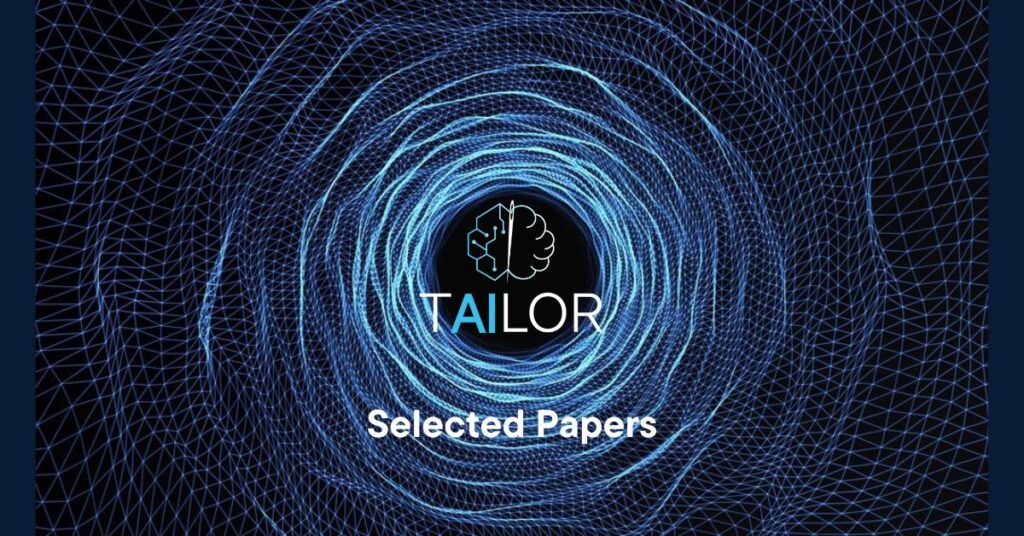Every month, we want to acknowledge some valuable TAILOR papers, selected among the papers published by scientists belonging to our network by TAILOR principal investigator Fredrik Heintz.
The list of the most valuable papers gathers contributions from different TAILOR partners, each providing valuable insights on different topics related to TrustworthyAI.
Stay tuned for other valuable insights and groundbreaking research from our diverse community!
Team formation through an assessor: choosing MARL agents in pursuit–evasion games
Y Zhao, L Ju, J Hernández-Orallo
Complex & Intelligent Systems, 2024 – Springer
Abstract: Team formation in multi-agent systems usually assumes the capabilities of each team member are known, and the best formation can be derived from that information. As AI agents become more sophisticated, this characterisation is becoming more elusive and less predictive about the performance of a team in cooperative or competitive situations. In this paper, we introduce a general and flexible way of anticipating the outcome of a game for any lineups (the agents, sociality regimes and any other hyperparameters for the team). To this purpose, we simply train an assessor using an appropriate team representation and standard machine learning techniques. We illustrate how we can interrogate the assessor to find the best formations in a pursuit–evasion game for several scenarios: offline team formation, where teams have to be decided before the game and not changed afterwards, and online team formation, where teams can see the lineups of the other teams and can be changed at any time.
Download the paper here: https://rdcu.be/dAgRT
Query-driven Qualitative Constraint Acquisition
Mohamed Bachir BELAID, Nassim Belmecheri, Arnaud Gotlieb, Nadjib Lazaar, and Helge Spieker
Journal of Artificial Intelligence Research 79 (2024) 241-271
Abstract: Many planning, scheduling or multi-dimensional packing problems involve the design of subtle logical combinations of temporal or spatial constraints. Recently, we introduced GEQCA-I, which stands for Generic Qualitative Constraint Acquisition, as a new active constraint acquisition method for learning qualitative constraints using qualitative queries. In this paper, we revise and extend GEQCA-I to GEQCA-II with a new type of query, universal query, for qualitative constraint acquisition, with a deeper query-driven acquisition algorithm. Our extended experimental evaluation shows the efficiency and usefulness of the concept of universal query in learning randomly-generated qualitative networks, including both temporal networks based on Allen’s algebra and spatial networks based on region connection calculus. We also show the effectiveness of GEQCA-II in learning the qualitative part of real scheduling problems.
Download the paper here: https://www.jair.org/index.php/jair/article/view/14752/27003
AutoSR4EO: An AutoML Approach to Super-Resolution for Earth Observation Images
Wąsala J, Marselis S, Arp L, Hoos H, Longépé N, Baratchi M.
Remote Sensing. 2024; 16(3):443. https://doi.org/10.3390/rs16030443
Abstract: Super-resolution (SR), a technique to increase the resolution of images, is a pre-processing step in the pipelines of applications of Earth observation (EO) data. The manual design and optimisation of SR models that are specific to every possible EO use case is a laborious process that creates a bottleneck for EO analysis. In this work, we develop an automated machine learning (AutoML) method to automate the creation of dataset-specific SR models. AutoML is the study of the automatic design of high-performance machine learning models. We present the following contributions. (i) We propose AutoSR4EO, an AutoML method for automatically constructing neural networks for SR. We design a search space based on state-of-the-art residual neural networks for SR and incorporate transfer learning. Our search space is extendable, making it possible to adapt AutoSR4EO to future developments in the field. (ii) We introduce a new real-world single-image SR (SISR) dataset, called SENT-NICFI. (iii) We evaluate the performance of AutoSR4EO on four different datasets against the performance of four state-of-the-art baselines and a vanilla AutoML SR method, with AutoSR4EO achieving the highest average ranking. Our results show that AutoSR4EO performs consistently well over all datasets, demonstrating that AutoML is a promising method for improving SR techniques for EO images.
Keywords: super-resolution; neural architecture search; automated machine learning
Read the article in open access here: https://www.mdpi.com/2072-4292/16/3/443
Evolution of a theory of mind
Tom Lenaerts, Marco Saponara, Jorge Pacheco, and Francisco Santos.
Iscience, 27(2)
Abstract: Even though the Theory of Mind in upper primates has been under investigation for decades, how it may evolve remains an open problem. We propose here an evolutionary game theoretical model where a finite population of individuals may use reasoning strategies to infer a response to the anticipated behavior of others within the context of a sequential dilemma, i.e., the Centipede Game. We show that strategies with bounded reasoning evolve and flourish under natural selection, provided they are allowed to make reasoning mistakes and a temptation for higher future gains is in place. We further show that non-deterministic reasoning co-evolves with an optimism bias that may lead to the selection of new equilibria, closely associated with average behavior observed in experimental data. This work reveals both a novel perspective on the evolution of bounded rationality and a co-evolutionary link between the evolution of Theory of Mind and the emergence of misbeliefs.
Find the paper in open access here: https://www.cell.com/iscience/pdf/S2589-0042(24)00083-X.pdf
